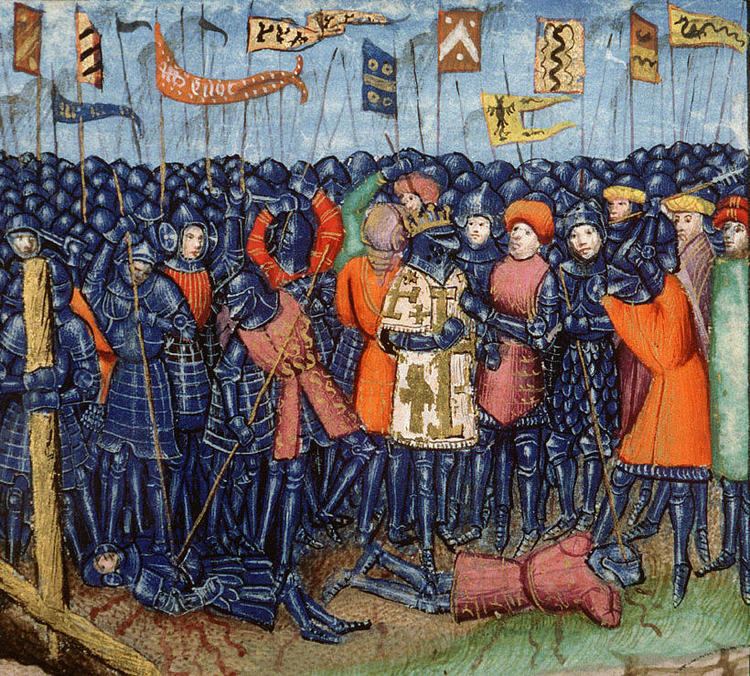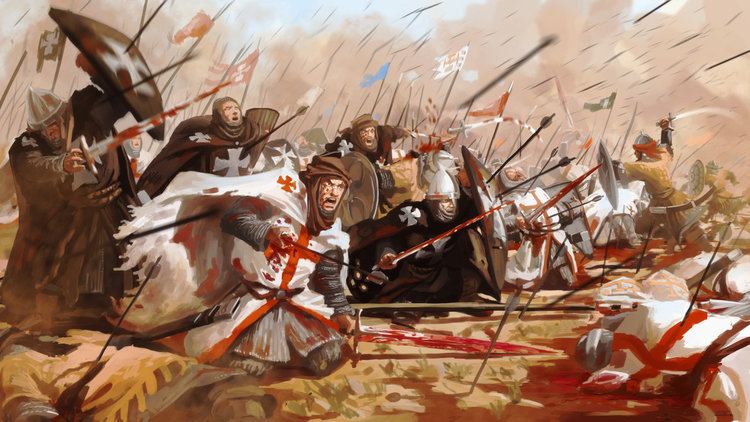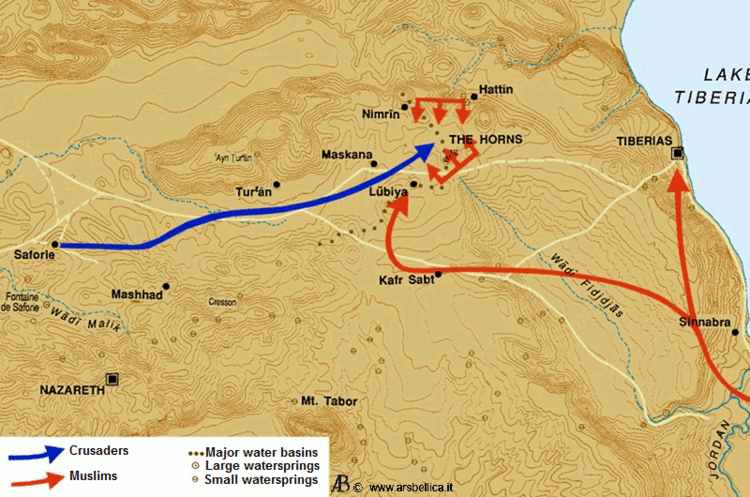believed heavy believed light | Date 4 July 1187 | |
 | ||
Similar | ||
Battle of hattin kingdom of heaven 2005
The Battle of Hattin took place on July 4, 1187, between the Crusader Kingdom of Jerusalem and the forces of the Ayyubid sultan Salah ad-Din, known in the West as Saladin. It is also known as the Battle of the Horns of Hattin, from a nearby extinct volcano.
Contents
- Battle of hattin kingdom of heaven 2005
- Location
- Background
- Siege of Tiberias
- The Battle
- Surrender of crusaders
- Aftermath
- References

The Muslim armies under Saladin captured or killed the vast majority of the Crusader forces, removing their capability to wage war. As a direct result of the battle, Muslims once again became the eminent military power in the Holy Land, re-conquering Jerusalem and several other Crusader-held cities. These Christian defeats prompted the Third Crusade, which began two years after the Battle of Hattin.

Location

The battle took place near Tiberias in present-day Israel. The battlefield, near the town of Hittin, had as its chief geographic feature a double hill (the "Horns of Hattin") beside a pass through the northern mountains between Tiberias and the road from Acre to the east. The Darb al-Hawarnah road, built by the Romans, served as the main east-west passage between the Jordan fords, the Sea of Galilee and the Mediterranean coast.
Background

Guy of Lusignan became king of Jerusalem in 1186, in right of his wife Sibylla, after the death of Sibylla's son Baldwin V. The Kingdom of Jerusalem was at this time divided between the "court faction" of Guy, Sibylla, and relative newcomers to the kingdom such as Raynald of Châtillon, Gerard of Ridefort and the Knights Templar; and the "nobles’ faction", led by Raymond III of Tripoli, who had been regent for the child-king Baldwin V and had opposed the succession of Guy. Raymond III of Tripoli had supported the claim of Isabella of Jerusalem and her husband Humphrey IV of Toron, and he led the rival faction to the court party. Open warfare was only prevented when Humphrey of Toron swore allegiance to Guy, ending the succession dispute. The Muslim chronicler Ali ibn al-Athir claimed that Raymond was in a "state of open rebellion" against Guy.
In the background of these divisions Saladin had become vizier of Egypt in 1169, had taken Damascus in 1174 and Aleppo in 1183. He controlled the entire Southern and Eastern flanks of the Crusader states. Through the use of propaganda he united his subjects under Sunni Islam, and convinced them that he would wage Holy War to push the Christian Franks from Jerusalem. However, Saladin often made strategic truces with the Franks when there was a need to deal with political problems in the Muslim World, and one such truce was made in 1185. It was rumoured amongst the Franks that Raymond III of Tripoli had made a deal with Saladin under which Saladin would make him King of Jerusalem in return for peace. This rumour was echoed by Ibn al Athir, but it is unclear whether it was true. Raymond III was certainly reluctant to engage in battle with Saladin.
In 1187 Reynald of Châtillon raided a Muslim caravan when the truce with Saladin was still in place, and some accounts claim that Saladin's sister was raped during the attack. Saladin swore that he would kill Reynald, and sent his son Al-Afdal ibn Salah ad-Din to raid Frankish lands surrounding Acre. Gerard de Ridefort and the Templars engaged al Afdal in The Battle of the Springs of Cresson in May, where they were heavily defeated. The Templars lost around 150 knights and 300 footsoldiers, who had made up a great part of the military of Jerusalem. Phillips states that "the damage to Frankish morale and the scale of the losses should not be underestimated in contributing towards the defeat at Hattin".
In July Saladin laid siege to Tiberias, where Raymond III's wife Eschiva was trapped. In spite of this Raymond argued that Guy should not engage Saladin in battle, and that Saladin could not hold Tiberias because his troops would not stand to be away from their families for so long. The Knights Hospitaller also advised Guy not to provoke Saladin. However, Gerard de Ridefort advised Guy to advance against Saladin, and Guy took his advice. Norman Housley suggests that this was because "the minds of both men had been so poisoned by the political conflict 1180-87 that they could only see Raymond's advice as designed to bring them personal ruin", and also because he had spent Henry II of England's donations in calling the army, and was reluctant to disband it without a battle. This was a gamble on Guy's part, as he left only a few knights to defend the city of Jerusalem.
Siege of Tiberias
In late May Saladin assembled the largest army he had ever commanded, around some 30,000 men including about 12,000 regular cavalry. He inspected his forces at Tell-Ashtara before crossing the River Jordan on June 30. The opposing Crusader army amassed at La Saphorie; it consisted of around 20,000 men, including 1,200 knights from Jerusalem and Tripoli and 50 from Antioch. Though the army was smaller than Saladin's it was still larger than those usually mustered by the Crusaders. After reconciling, Raymond and Guy met at Acre with the bulk of the crusader army. According to the claims of some European sources, aside from the knights there was a greater number of lighter cavalry, and perhaps 10,000 foot soldiers, supplemented by crossbowmen from the Italian merchant fleet, and a large number of mercenaries (including Turcopoles) hired with money donated to the kingdom by Henry II, King of England. Also the army's standard was the relic of the True Cross, carried by the Bishop of Acre, who was there in place of the ailing Patriarch Heraclius.
On July 2, Saladin, who wanted to lure Guy into moving his field army away from their encampment by the springs at La Saphorie, personally led a siege of Raymond's fortress of Tiberias while the main Muslim army remained at Kafr Sabt. The garrison at Tiberias tried to pay Saladin off, but he refused, later stating that "when the people realized they had an opponent who could not be tricked and would not be contented with tribute, they were afraid lest war might eat them up and they asked for quarter...but the servant gave the sword dominion over them." The fortress fell the same day. A tower was mined and, when it fell, Saladin's troops stormed the breach killing the opposing forces and taking prisoners.
Holding out, Raymond's wife Eschiva was besieged in the citadel. As the mining was begun on that structure, news was received by Saladin that Guy was moving the Frank army east. The Crusaders had taken the bait.
Guy's decision to leave the secure base provided by his well-watered assembly point at La Saphorie, was the result of a Crusader war council held the night of July 2. Though reports of what happened at this meeting are biased due to personal feuds among the Franks, it seems Raymond argued that a march from Acre to Tiberias was exactly what Saladin wanted while La Saphorie was a strong position for the Crusaders to defend. Furthermore, Guy shouldn't worry about Tiberias, which Raymond held personally and was willing to give up for the safety of the kingdom. In response to this argument, and despite their reconciliation (internal court politics remaining strong), Raymond was accused of cowardice by Gerard and Raynald. The latter influenced Guy to attack immediately.
Guy thus ordered the army to march against Saladin at Tiberias, which is indeed just what Saladin had planned, for he had calculated that he could defeat the crusaders only in a field battle rather than by besieging their fortifications.
Saladin had also unexpectedly gained the alliance of the Druze community based in Sarahmul led by Jamal ad-Din Hajji, whose father Karama was an age-old ally of Nur ad-Din Zangi. The city of Sarahmul had been sacked by the crusaders on various occasions and according to Jamal ad-Din Hajji the crusaders even manipulated the Assassins to kill his three elder brothers.
The Battle
On July 3 the Frankish army started out towards Tiberias, harassed constantly by Muslim archers. They passed the Springs of Turan, which were entirely insufficient to provide the army with water. At midday Raymond of Tripoli decided that the army would not reach Tiberias by nightfall, and he and Guy agreed to change the course of the march in the direction of the Springs of Kafr Hattin. The Muslims positioned themselves between the Frankish army and the water so that the Franks were forced to pitch camp overnight on a waterless plain at Meskenah. The Muslims surrounded the camp so closely that "a cat could not have escaped". According to Ibn al Athir the Franks were "despondent, tormented by thirst" whilst Saladin's men were jubilant in anticipation of their victory.
On the morning of 4 July Muslim attacks began at around 9am. The Frankish army, severely outnumbered and dying of thirst, attempted to fight their way through to the Springs of Kafr Hattin. Light Muslim cavalry and archers harried the slow moving infantry as it moved to protect the heavy cavalry, but the thirst and exhaustion of the infantry meant that they were unable to hold their ground, and many of them fled up the slopes of the Horns of Hattin. Phillips describes the Frankish army as being "like a train running out of momentum, slowing grinding to a halt". Raymond III of Tripoli charged at the Muslim lines and they parted for him, allowing him to reach the springs. Ibn al Athir claimed that this was because he had made an agreement with Saladin, but Newby argues that parting before Raymond's charge was simply a Muslim battle tactic. The Franks took this as an indication of Raymond's betrayal.
Guy's red tent was captured and the relic of the True Cross was taken. Guy and Reynald of Chatillon were taken prisoner by Saladin.
Surrender of crusaders
Prisoners after the battle included Guy, his brother Amalric II, Raynald de Chatillon, William V of Montferrat, Gerard de Ridefort, Humphrey IV of Toron, Hugh of Jabala, Plivain of Botron, Hugh of Gibelet, and other barons of the Kingdom of Jerusalem. Perhaps only as few as 3,000 Christians escaped the defeat.
Guy of Lusignan and Reynald of Chatillon were brought to Saladin's tent. Saladin offered Guy a drink, which was a sign in Muslim culture that the prisoner would be spared, although Guy was unaware of this. Guy passed the goblet to Reynald, but Saladin struck it from his hands, saying "I did not ask this evil man to drink, and he would not save his life by doing so". He then charged Reynald with breaking the truce. Some reports, such as that of Baha al' Din, claim that Saladin then executed Reynald himself with a single stroke of his sword. However, others record that Saladin struck Reynald as a sign to his bodyguards to behead him. Guy assumed that he would also be beheaded, but Saladin assured him that "Kings do not kill Kings",.
Saladin commanded that the other captive barons were to be spared and treated humanely. All 200 of the Templar and Hospitaller Knights taken prisoner were executed on Saladin's orders, with the exception of the Grand Master of the Temple. The executions were by decapitation. Saint Nicasius, a Knight Hospitaller venerated as a Christian martyr, is said to have been one of the victims.
Imad ed-Din, Saladin's secretary, wrote:
"Saladin ordered that they should be beheaded, choosing to have them dead rather than in prison. With him was a whole band of scholars and sufis and a certain number of devout men and ascetics, each begged to be allowed to kill one of them, and drew his sword and rolled back his sleeve. Saladin, his face joyful, was sitting on his dais, the unbelievers showed black despair."
Captured turcopoles (locally recruited mounted archers employed by the crusader states) were also executed on Saladin's orders. While nominally Christian, these auxiliaries were regarded as renegades who had betrayed Islam.
The rest of the captured knights and soldiers were sold into slavery, and one was reportedly bought in Damascus in exchange for some sandals. The high ranking Frankish barons captured were held for ransom.
Aftermath
The True Cross was fixed upside down on a lance and sent to Damascus. Some of Saladin's men now left the army, taking lower ranking Frankish prisoners with them as slaves.
On Sunday, July 5, Saladin traveled the six miles (10 km) to Tiberias and, there, Countess Eschiva surrendered the citadel of the fortress. She was allowed to leave for Tripoli with all her family, followers, and possessions. Raymond of Tripoli, having escaped the battle, died of pleurisy later in 1187.
Guy was taken to Damascus as a prisoner and the other noble captives were eventually ransomed.
In fielding an army of 20,000 men, the Crusaders states had reduced the garrisons of their castles and fortified settlements. The heavy defeat at Hattin meant there was little reserve with which to defend against Saladin's forces. The importance of the defeat is demonstrated by the fact that in its aftermath fifty-two towns and fortifications were captured by Saladin's forces. By mid-September, Saladin had taken Acre, Nablus, Jaffa, Toron, Sidon, Beirut, and Ascalon. Tyre was saved by the arrival of Conrad of Montferrat, resulting in Saladin's assault being repulsed with heavy losses. Jerusalem was defended by Queen Sibylla, Patriarch Heraclius, and Balian, who subsequently negotiated its surrender to Saladin on October 2 (see Siege of Jerusalem).
According to the chronicler Ernoul, news of the defeat caused Pope Urban III to die of shock.
When Joscius, Archbishop of Tyre told Pope Gregory VIII of the disastrous defeat at Hattin, Pope Gregory VIII issued the bull Audita tremendi calling for a new crusade. In England and France the Saladin tithe was enacted to raise funds for the new crusade.
The subsequent Third Crusade did not get underway until 1189. The three separate contingents of the Third Crusade were led by Philip II of France, Richard I of England, and Frederick I, Holy Roman Emperor.
